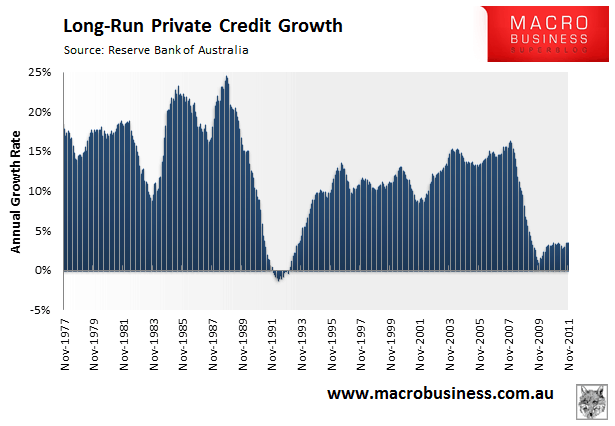
It appears that Australia’s stalling private credit growth is coming back to bite, with thousands of redundancies on the cards at some of Australia’s leading financial institutions and retailers also likely to follow suit.
AUSTRALIA is on the cusp of a white-collar recession with insiders warning that thousands of jobs are at risk in the finance sector, after it emerged yesterday that ANZ planned to cut 700 jobs.
But The Saturday Age has established the job cuts will total as many as 1000 by the end of this year, which will be more than the bank shed at the height of the global financial crisis.
They come a day after the Royal Bank of Scotland announced plans to close its investment banking business, leading to the loss of more than 200 jobs in Australia.
Economists have warned Australia is vulnerable to a recession this year with a wholesale funding squeeze in Europe raising debt costs for banks such as ANZ.
Experts say thousands of jobs will be lost from the industry this year as banks scramble to adjust to an era of low credit growth and higher funding costs…
Economists also say we might expect a further upheaval in the retail industry, which employs 1.2 million people, following the job losses last year.
The Grattan Institute’s Saul Eslake said: ”I think there will be a shake-out in employment in retailing this year.”
Fairfax then followed up yesterday with more alarming information on the level of job losses expected over coming years and some of the likely causes:
The big banks are likely to scrap 7000 jobs over the next two years as lenders cut costs that account for 58 per cent of expenses to offset the weakest credit growth since World War II, according to UBS.
Lenders will reduce total staff numbers by 3.9 per cent to 172,000 from 179,000, UBS analysts said in a note to clients…
The focus on employment costs at banks mirror the challenge faced around the world by lenders battling slower revenue growth amid weak household and business confidence…
‘‘We expect the banks to be heavily focused on their cost bases,’’ the UBS analysts said. ‘‘Solid reductions in headcount and discretionary costs are anticipated as banks react to the lower growth environment.’’
UBS continues ‘‘to be cautious on the outlook for credit growth’’ and doesn’t expect a ‘‘significant pickup in the housing market’’, the note said…
Australia’s banks in recent years became ‘‘more lax’’ in managing staff numbers as they invested to meet expanding demand for lending, after reducing headcount to 141,000 in 2002 from 166,000 in 1996, according to UBS.
Being someone that has just left a position at a large investment bank, and has friends and relatives working in banking, I can attest that the jobs situation in the financial sector is looking grim. And it’s a situation that is being played-out globally, with the Australian Financial Review reporting over the weekend that employee headcounts in some of the world’s largest global banks are being cut aggressively, including:
- UBS: 1,500 jobs to be cut by 2013, with 500 more by 2016;
- Credit Suisse: 3,500 jobs scheduled to go;
- Royal Bank of Scotland: 3,500 jobs over three years plus 2,000 already targeted in global banking and markets;
- Citigroup: 4,500 jobs;
- Deutsche Bank: 500 jobs across corporate and investment banking;
- Morgan Stanley: 1,600 jobs in the first quarter of 2012; and
- Bank of America Merrill Lynch: 30,000 jobs.
Fortunately, Australia’s big four banks resisted large scale job losses in the wake of the Global Financial Crisis, courtesy of the bounce in mortgage lending following the introduction of the Rudd Government’s first home buyer bonus and the sharp reduction of official interest rates by the Reserve Bank of Australia. Australian retailers (and the broader economy) were also supported heavily by the Government’s household stimulus payments and infrastructure subsidies, which supported spending and jobs.
But with the Government increasingly unlikely to step in and stimulate once more, owing to its status as implicit guarantor of Australia’s banks and the associated requirement that it maintains a strong fiscal position. And with private credit growth at 20-year lows and home prices flat to falling, job prospects in both the financial sector and retailing are looking increasingly fragile, with a larger shakeout looming.
Of course, such a shake-out was always on the cards once credit growth and house prices turned down, owing to the wealth-effect explained in a previous article:
…throughout the 2000s, when global credit conditions were benign, household debt levels and asset prices rose continually. These conditions made Australians feel richer (the ‘wealth effect’), spurring consumer confidence, spending and employment growth…
With house prices rising inexorably, Australians began using their homes as ATMs, withdrawing large amounts of their new found home equity…Much of this money was spent on consumption, thus further boosting incomes and employment.
However, the process of debt feeding asset prices feeding confidence, consumer spending and employment growth appears to have stalled now that house prices have flat-lined. Australians have, instead, begun reducing consumption and repaying debt…
The golden era for retailing [and banking] that was 2000 to 2008 is now over and the age of frugality has begun.
Overlay Australia’s sluggish credit growth and house prices with its ageing population and rising dependency rates, and it’s not hard see why the non-mining economy is struggling.
The banks are a leading indicator for further white collar job losses in 2012.

